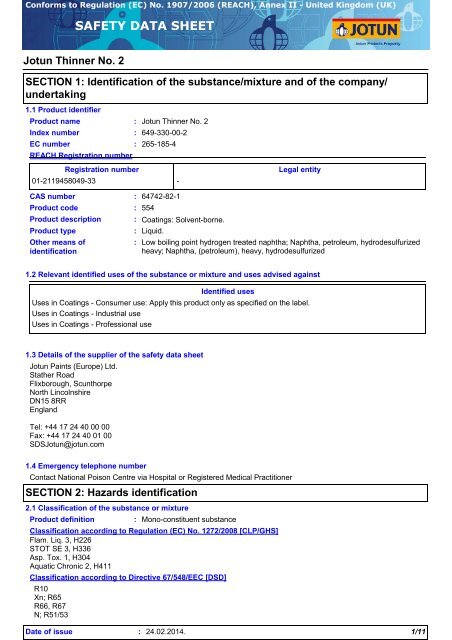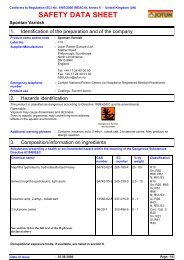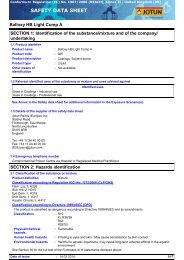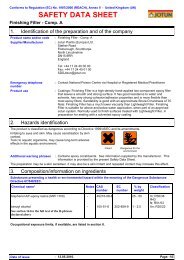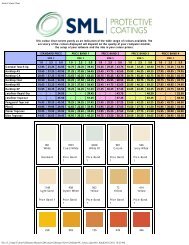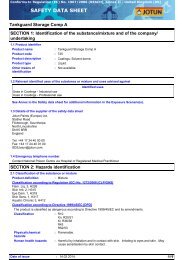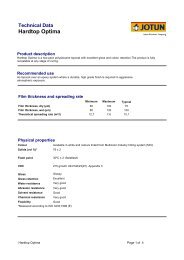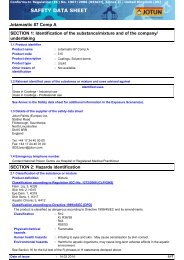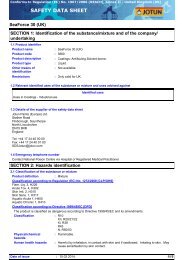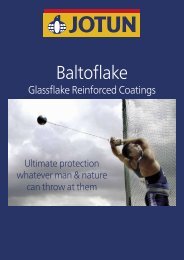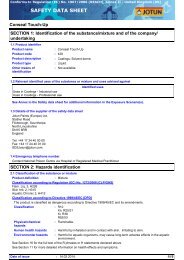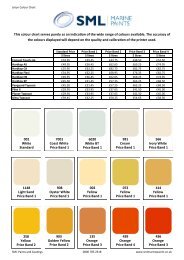Safety data sheet for Jotun Thinner No. 2 - English (uk)
Safety data sheet for Jotun Thinner No. 2 - English (uk)
Safety data sheet for Jotun Thinner No. 2 - English (uk)
- No tags were found...
You also want an ePaper? Increase the reach of your titles
YUMPU automatically turns print PDFs into web optimized ePapers that Google loves.
Con<strong>for</strong>ms to Regulation (EC) <strong>No</strong>. 1907/2006 (REACH), Annex II - United Kingdom (UK)SAFETY DATA SHEET<strong>Jotun</strong> <strong>Thinner</strong> <strong>No</strong>. 2SECTION 1: Identification of the substance/mixture and of the company/undertaking1.1 Product identifierProduct name :Product type :Other means ofidentification:<strong>Jotun</strong> <strong>Thinner</strong> <strong>No</strong>. 2Index number : 649-330-00-2EC number : 265-185-4REACH Registration numberRegistration number01-2119458049-33 -CAS number : 64742-82-1Product code :Product description :554Coatings: Solvent-borne.Liquid.Legal entityLow boiling point hydrogen treated naphtha; Naphtha, petroleum, hydrodesulfurizedheavy; Naphtha, (petroleum), heavy, hydrodesulfurized1.2 Relevant identified uses of the substance or mixture and uses advised againstIdentified usesUses in Coatings - Consumer use: Apply this product only as specified on the label.Uses in Coatings - Industrial useUses in Coatings - Professional useConsumer applications, Industrial applications, Professional applications, Used by spraying.1.3 Details of the supplier of the safety <strong>data</strong> <strong>sheet</strong><strong>Jotun</strong> Paints (Europe) Ltd.Stather RoadFlixborough, Scunthorpe<strong>No</strong>rth LincolnshireDN15 8RREnglandTel: +44 17 24 40 00 00Fax: +44 17 24 40 01 00SDS<strong>Jotun</strong>@jotun.com1.4 Emergency telephone numberContact National Poison Centre via Hospital or Registered Medical PractitionerSECTION 2: Hazards identification2.1 Classification of the substance or mixtureProduct definition: Mono-constituent substanceClassification according to Regulation (EC) <strong>No</strong>. 1272/2008 [CLP/GHS]Flam. Liq. 3, H226STOT SE 3, H336Asp. Tox. 1, H304Aquatic Chronic 2, H411Classification according to Directive 67/548/EEC [DSD]R10Xn; R65R66, R67N; R51/53Date of issue : 24.02.2014.1/11
Con<strong>for</strong>ms to Regulation (EC) <strong>No</strong>. 1907/2006 (REACH), Annex II - United Kingdom (UK)<strong>Jotun</strong> <strong>Thinner</strong> <strong>No</strong>. 2SECTION 2: Hazards identificationSee Section 16 <strong>for</strong> the full text of the R phrases or H statements declared above.See Section 11 <strong>for</strong> more detailed in<strong>for</strong>mation on health effects and symptoms.2.2 Label elementsHazard pictograms :Signal word :Hazard statements :Precautionary statementsGeneralPrevention :Response :Storage :Disposal :Hazardous ingredientsSupplemental labelelementsDangerFlammable liquid and vapour.May be fatal if swallowed and enters airways.May cause drowsiness or dizziness.Toxic to aquatic life with long lasting effects.: Keep out of reach of children.Keep away from heat, sparks, open flames and hot surfaces. - <strong>No</strong> smoking. Useonly outdoors or in a well-ventilated area. Avoid release to the environment.IF SWALLOWED: Immediately call a POISON CENTER or physician. Do NOTinduce vomiting.Keep cool.Dispose of contents and container in accordance with all local, regional, nationaland international regulations.: Naphtha (petroleum), hydrodesulfurized heavy: Repeated exposure may cause skin dryness or cracking.2.3 Other hazardsSubstance meets thecriteria <strong>for</strong> PBT accordingto Regulation (EC) <strong>No</strong>.1907/2006, Annex XIIISubstance meets thecriteria <strong>for</strong> vPvB accordingto Regulation (EC) <strong>No</strong>.1907/2006, Annex XIIIOther hazards which donot result in classification: <strong>No</strong>.P: <strong>No</strong>t available. B: <strong>No</strong>t available. T: <strong>No</strong>.: <strong>No</strong>t available.:<strong>No</strong>ne known.SECTION 3: Composition/in<strong>for</strong>mation on ingredientsSubstance/mixtureProduct/ingredientname:Mono-constituent substanceIdentifiersClassification% 67/548/EEC Regulation (EC) <strong>No</strong>. Type1272/2008 [CLP]<strong>No</strong>tesNaphtha (petroleum),hydrodesulfurizedheavyREACH #:01-2119458049-33EC: 265-185-4CAS: 64742-82-1Index: 649-330-00-250 -100R10Xn; R65R66, R67N; R51/53Flam. Liq. 3, H226STOT SE 3, H336Asp. Tox. 1, H304Aquatic Chronic 2,H411[A]H-PSee Section 16 <strong>for</strong>the full text of theR-phrases declaredabove.See Section 16 <strong>for</strong>the full text of the Hstatementsdeclared above.Date of issue : 24.02.2014.2/11
Con<strong>for</strong>ms to Regulation (EC) <strong>No</strong>. 1907/2006 (REACH), Annex II - United Kingdom (UK)<strong>Jotun</strong> <strong>Thinner</strong> <strong>No</strong>. 2SECTION 3: Composition/in<strong>for</strong>mation on ingredientsThere are no additional ingredients present which, within the current knowledge of the supplier, are classified andcontribute to the classification of the substance and hence require reporting in this section.Occupational exposure limits, if available, are listed in Section 8.SECTION 4: First aid measures4.1 Description of first aid measuresGeneralInhalationSkin contactEye contactIngestionProtection of first-aiders::::In all cases of doubt, or when symptoms persist, seek medical attention. Never giveanything by mouth to an unconscious person. If unconscious, place in recoveryposition and seek medical advice.Remove to fresh air. Keep person warm and at rest. If not breathing, if breathing isirregular or if respiratory arrest occurs, provide artificial respiration or oxygen bytrained personnel.Remove contaminated clothing and shoes. Wash skin thoroughly with soap andwater or use recognised skin cleanser. Do NOT use solvents or thinners.Check <strong>for</strong> and remove any contact lenses. Immediately flush eyes with runningwater <strong>for</strong> at least 15 minutes, keeping eyelids open. Seek immediate medicalattention.: If swallowed, seek medical advice immediately and show the container or label.Keep person warm and at rest. Do NOT induce vomiting.: <strong>No</strong> action shall be taken involving any personal risk or without suitable training. If itis suspected that fumes are still present, the rescuer should wear an appropriatemask or self-contained breathing apparatus. It may be dangerous to the personproviding aid to give mouth-to-mouth resuscitation.4.2 Most important symptoms and effects, both acute and delayedPotential acute health effectsEye contactInhalationSkin contact:<strong>No</strong> known significant effects or critical hazards.: Can cause central nervous system (CNS) depression. May cause drowsiness ordizziness.: Defatting to the skin. May cause skin dryness and irritation.Ingestion: Can cause central nervous system (CNS) depression. May be fatal if swallowedand enters airways.Over-exposure signs/symptomsEye contactInhalationSkin contactIngestion: <strong>No</strong> specific <strong>data</strong>.:::Adverse symptoms may include the following:nausea or vomitingheadachedrowsiness/fatiguedizziness/vertigounconsciousnessAdverse symptoms may include the following:irritationdrynesscrackingAdverse symptoms may include the following:nausea or vomiting4.3 Indication of any immediate medical attention and special treatment needed<strong>No</strong>tes to physicianSpecific treatments::Treat symptomatically. Contact poison treatment specialist immediately if largequantities have been ingested or inhaled.<strong>No</strong> specific treatment.Date of issue : 24.02.2014.3/11
Con<strong>for</strong>ms to Regulation (EC) <strong>No</strong>. 1907/2006 (REACH), Annex II - United Kingdom (UK)<strong>Jotun</strong> <strong>Thinner</strong> <strong>No</strong>. 2SECTION 5: Firefighting measures5.1 Extinguishing mediaSuitable extinguishingmediaUnsuitable extinguishingmedia::Recommended: alcohol-resistant foam, CO₂, powders, water spray.Do not use water jet.5.2 Special hazards arising from the substance or mixtureHazards from thesubstance or mixtureHazardous thermaldecomposition products::Flammable liquid and vapour. In a fire or if heated, a pressure increase will occurand the container may burst, with the risk of a subsequent explosion. Runoff tosewer may create fire or explosion hazard. This material is toxic to aquatic life withlong lasting effects. Fire water contaminated with this material must be containedand prevented from being discharged to any waterway, sewer or drain.<strong>No</strong> specific <strong>data</strong>.5.3 Advice <strong>for</strong> firefightersSpecial protective actions<strong>for</strong> fire-fightersSpecial protectiveequipment <strong>for</strong> fire-fighters::Promptly isolate the scene by removing all persons from the vicinity of the incident ifthere is a fire. <strong>No</strong> action shall be taken involving any personal risk or withoutsuitable training. Move containers from fire area if this can be done without risk.Use water spray to keep fire-exposed containers cool.Fire-fighters should wear appropriate protective equipment and self-containedbreathing apparatus (SCBA) with a full face-piece operated in positive pressuremode. Clothing <strong>for</strong> fire-fighters (including helmets, protective boots and gloves)con<strong>for</strong>ming to European standard EN 469 will provide a basic level of protection <strong>for</strong>chemical incidents.SECTION 6: Accidental release measures6.1 Personal precautions, protective equipment and emergency proceduresFor non-emergencypersonnelFor emergency responders ::<strong>No</strong> action shall be taken involving any personal risk or without suitable training.Evacuate surrounding areas. Keep unnecessary and unprotected personnel fromentering. Do not touch or walk through spilt material. Shut off all ignition sources.<strong>No</strong> flares, smoking or flames in hazard area. Avoid breathing vapour or mist.Provide adequate ventilation. Wear appropriate respirator when ventilation isinadequate. Put on appropriate personal protective equipment.If specialised clothing is required to deal with the spillage, take note of anyin<strong>for</strong>mation in Section 8 on suitable and unsuitable materials. See also thein<strong>for</strong>mation in "For non-emergency personnel".6.2 Environmentalprecautions:Avoid dispersal of spilt material and runoff and contact with soil, waterways, drainsand sewers. In<strong>for</strong>m the relevant authorities if the product has caused environmentalpollution (sewers, waterways, soil or air). Water polluting material. May be harmfulto the environment if released in large quantities. Collect spillage.6.3 Methods and materials <strong>for</strong> containment and cleaning upSmall spill :Large spill :Stop leak if without risk. Move containers from spill area. Use spark-proof tools andexplosion-proof equipment. Dilute with water and mop up if water-soluble.Alternatively, or if water-insoluble, absorb with an inert dry material and place in anappropriate waste disposal container. Dispose of via a licensed waste disposalcontractor.Stop leak if without risk. Move containers from spill area. Use spark-proof tools andexplosion-proof equipment. Approach the release from upwind. Prevent entry intosewers, water courses, basements or confined areas. Wash spillages into aneffluent treatment plant or proceed as follows. Contain and collect spillage with noncombustible,absorbent material e.g. sand, earth, vermiculite or diatomaceous earthand place in container <strong>for</strong> disposal according to local regulations. Dispose of via alicensed waste disposal contractor. Contaminated absorbent material may pose thesame hazard as the spilt product.Date of issue : 24.02.2014.4/11
Con<strong>for</strong>ms to Regulation (EC) <strong>No</strong>. 1907/2006 (REACH), Annex II - United Kingdom (UK)<strong>Jotun</strong> <strong>Thinner</strong> <strong>No</strong>. 2SECTION 8: Exposure controls/personal protectionRecommended monitoringproceduresDerived no effect levelsNaphtha (petroleum),hydrodesulfurized heavy:If this product contains ingredients with exposure limits, personal, workplaceatmosphere or biological monitoring may be required to determine the effectivenessof the ventilation or other control measures and/or the necessity to use respiratoryprotective equipment. Reference should be made to monitoring standards, such asthe following: European Standard EN 689 (Workplace atmospheres - Guidance <strong>for</strong>the assessment of exposure by inhalation to chemical agents <strong>for</strong> comparison withlimit values and measurement strategy) European Standard EN 14042 (Workplaceatmospheres - Guide <strong>for</strong> the application and use of procedures <strong>for</strong> the assessmentof exposure to chemical and biological agents) European Standard EN 482(Workplace atmospheres - General requirements <strong>for</strong> the per<strong>for</strong>mance of procedures<strong>for</strong> the measurement of chemical agents) Reference to national guidancedocuments <strong>for</strong> methods <strong>for</strong> the determination of hazardous substances will also berequired.Product/ingredient name Type Exposure Value Population EffectsPredicted no effect concentrations<strong>No</strong> PNECs available.DNEL Long term 330 mg/m³ Workers SystemicInhalationDNEL Long term Dermal 44 mg/kg Workers Systemicbw/dayDNEL Long term 71 mg/m³ Consumers SystemicInhalationDNEL Long term Dermal 26 mg/kg Consumers Systemicbw/dayDNEL Long term Oral 26 mg/kgbw/dayConsumers Systemic8.2 Exposure controlsAppropriate engineeringcontrolsIndividual protection measuresHygiene measures :Eye/face protectionSkin protectionHand protection: Use only with adequate ventilation. Use process enclosures, local exhaustventilation or other engineering controls to keep worker exposure to airbornecontaminants below any recommended or statutory limits. The engineeringcontrols also need to keep gas, vapour or dust concentrations below any lowerexplosive limits. Use explosion-proof ventilation equipment.::Wash hands, <strong>for</strong>earms and face thoroughly after handling chemical products,be<strong>for</strong>e eating, smoking and using the lavatory and at the end of the working period.Appropriate techniques should be used to remove potentially contaminated clothing.Wash contaminated clothing be<strong>for</strong>e reusing. Ensure that eyewash stations andsafety showers are close to the workstation location.<strong>Safety</strong> eyewear complying with an approved standard should be used when a riskassessment indicates this is necessary to avoid exposure to liquid splashes, mists,gases or dusts. If contact is possible, the following protection should be worn,unless the assessment indicates a higher degree of protection: safety glasses withside-shields.There is no one glove material or combination of materials that will give unlimitedresistance to any individual or combination of chemicals.The breakthrough time must be greater than the end use time of the product.The instructions and in<strong>for</strong>mation provided by the glove manufacturer on use,storage, maintenance and replacement must be followed.Gloves should be replaced regularly and if there is any sign of damage to the glovematerial.Always ensure that gloves are free from defects and that they are stored and usedcorrectly.The per<strong>for</strong>mance or effectiveness of the glove may be reduced by physical/chemical damage and poor maintenance.Barrier creams may help to protect the exposed areas of the skin but should not beapplied once exposure has occurred.Date of issue : 24.02.2014.6/11
Con<strong>for</strong>ms to Regulation (EC) <strong>No</strong>. 1907/2006 (REACH), Annex II - United Kingdom (UK)<strong>Jotun</strong> <strong>Thinner</strong> <strong>No</strong>. 2SECTION 8: Exposure controls/personal protectionBody protection :Other skin protectionRespiratory protection :Environmental exposurecontrols:For prolonged or repeated handling, use the following type of gloves:Recommended, gloves(breakthrough time) > 8 hours: nitrile rubberFor right choice of glove materials, with focus on chemical resistance and time ofpenetration, seek advice by the supplier of chemical resistant gloves.The user must check that the final choice of type of glove selected <strong>for</strong> handling thisproduct is the most appropriate and takes into account the particular conditions ofuse, as included in the user's risk assessment.Personal protective equipment <strong>for</strong> the body should be selected based on the taskbeing per<strong>for</strong>med and the risks involved and should be approved by a specialistbe<strong>for</strong>e handling this product. When there is a risk of ignition from static electricity,wear anti-static protective clothing. For the greatest protection from staticdischarges, clothing should include anti-static overalls, boots and gloves. Refer toEuropean Standard EN 1149 <strong>for</strong> further in<strong>for</strong>mation on material and designrequirements and test methods.Appropriate footwear and any additional skin protection measures should beselected based on the task being per<strong>for</strong>med and the risks involved and should beapproved by a specialist be<strong>for</strong>e handling this product.If workers are exposed to concentrations above the exposure limit, they must useappropriate, certified respirators. Use respiratory mask with charcoal and dust filterwhen spraying this product.(as filter combination A2-P2). In confined spaces, usecompressed-air or fresh-air respiratory equipment. When use of roller or brush,consider use of charcoalfilter.: Emissions from ventilation or work process equipment should be checked toensure they comply with the requirements of environmental protection legislation.In some cases, fume scrubbers, filters or engineering modifications to the processequipment will be necessary to reduce emissions to acceptable levels.SECTION 9: Physical and chemical properties9.1 In<strong>for</strong>mation on basic physical and chemical propertiesAppearancePhysical stateColourOdourOdour thresholdpHMelting point/freezing pointInitial boiling point andboiling rangeFlash pointVapour pressureVapour densityRelative densitySolubility(ies)Liquid.Various colours.Characteristic.<strong>No</strong>t available.<strong>No</strong>t applicable.200°C: <strong>No</strong>t available.< 20,5 mm2/s (40 °C)Date of issue : 24.02.2014.7/11
Con<strong>for</strong>ms to Regulation (EC) <strong>No</strong>. 1907/2006 (REACH), Annex II - United Kingdom (UK)<strong>Jotun</strong> <strong>Thinner</strong> <strong>No</strong>. 2SECTION 9: Physical and chemical propertiesExplosive properties : <strong>No</strong>t available.Oxidising properties : <strong>No</strong>t available.9.2 Other in<strong>for</strong>mation<strong>No</strong> additional in<strong>for</strong>mation.SECTION 10: Stability and reactivity10.1 Reactivity : <strong>No</strong> specific test <strong>data</strong> related to reactivity available <strong>for</strong> this product or its ingredients.10.2 Chemical stability10.3 Possibility ofhazardous reactions:The product is stable.: Under normal conditions of storage and use, hazardous reactions will not occur.10.4 Conditions to avoid10.5 Incompatible materials::Avoid all possible sources of ignition (spark or flame). Do not pressurise, cut, weld,braze, solder, drill, grind or expose containers to heat or sources of ignition.Reactive or incompatible with the following materials:oxidizing materials10.6 Hazardousdecomposition products: Under normal conditions of storage and use, hazardous decomposition productsshould not be produced.SECTION 11: Toxicological in<strong>for</strong>mation11.1 In<strong>for</strong>mation on toxicological effectsExposure to component solvent vapour concentrations in excess of the stated occupational exposure limit may resultin adverse health effects such as mucous membrane and respiratory system irritation and adverse effects on thekidneys, liver and central nervous system. Solvents may cause some of the above effects by absorption through theskin. Symptoms and signs include headache, dizziness, fatigue, muscular weakness, drowsiness and, in extremecases, loss of consciousness. Repeated or prolonged contact with the mixture may cause removal of natural fat fromthe skin, resulting in non-allergic contact dermatitis and absorption through the skin. If splashed in the eyes, the liquidmay cause irritation and reversible damage. Swallowing may cause nausea, diarrhoea, vomiting, gastro-intestinalirritation and chemical pneumonia. Aspiration hazard if swallowed. Can enter lungs and cause damage.Specific target organ toxicity (single exposure)Product/ingredient nameSpecific target organ toxicity (repeated exposure)Aspiration hazardProduct/ingredient nameCategoryRoute ofexposureResultNaphtha (petroleum), hydrodesulfurized heavy ASPIRATION HAZARD - Category 1Target organsNaphtha (petroleum), hydrodesulfurized heavy Category 3 <strong>No</strong>t applicable. Narcotic effects<strong>No</strong>t available.SECTION 12: Ecological in<strong>for</strong>mation12.1 ToxicityProduct/ingredient nameNaphtha (petroleum),hydrodesulfurized heavyConclusion/Summary :ResultSpeciesExposureAcute EC50
Con<strong>for</strong>ms to Regulation (EC) <strong>No</strong>. 1907/2006 (REACH), Annex II - United Kingdom (UK)<strong>Jotun</strong> <strong>Thinner</strong> <strong>No</strong>. 2SECTION 12: Ecological in<strong>for</strong>mationProduct/ingredient name Aquatic half-life Photolysis BiodegradabilityNaphtha (petroleum),hydrodesulfurized heavy- - <strong>No</strong>t readily12.3 Bioaccumulative potential<strong>No</strong>t available.12.4 Mobility in soilSoil/water partitioncoefficient (KOC)Mobility::<strong>No</strong>t available.<strong>No</strong>t available.12.5 Results of PBT and vPvB assessmentPBT: <strong>No</strong>.P: <strong>No</strong>t available. B: <strong>No</strong>t available. T: <strong>No</strong>.vPvB: <strong>No</strong>t available.vP: <strong>No</strong>t available. vB: <strong>No</strong>t available.12.6 Other adverse effects : <strong>No</strong> known significant effects or critical hazards.SECTION 13: Disposal considerationsThe in<strong>for</strong>mation in this section contains generic advice and guidance. The list of Identified Uses in Section 1 should beconsulted <strong>for</strong> any available use-specific in<strong>for</strong>mation provided in the Exposure Scenario(s).13.1 Waste treatment methodsDo not allow to enter drains or watercourses. Material and/or container must be disposed of as hazardous waste.European waste catalogue(EWC): 08 01 11* Waste paint and varnish containing organic solvents or other dangeroussubstances. If this product is mixed with other wastes, this code may no longer apply.If mixed with other wastes, the appropriate code should be assigned. For furtherin<strong>for</strong>mation, contact your local waste authority.SECTION 14: Transport in<strong>for</strong>mationTransport within user’s premises: always transport in closed containers that are upright and secure. Ensure thatpersons transporting the product know what to do in the event of an accident or spillage.Transport in accordance with ADR/RID, IMDG/IMO and ICAO/IATA and national regulation.International transport regulations14.1 UN number14.2 UN proper shippingname14.3 Transport hazardclass(es):::1300TURPENTINE SUBSTITUTE. Marine pollutant (Naphtha (petroleum),hydrodesulfurized heavy)3Marking14.4 Packing group14.5 Environmentalhazards: The environmental hazardous / marine pollutant mark is only applicable <strong>for</strong>packages containing more than 5 litres <strong>for</strong> liquids and 5 kg <strong>for</strong> solids.::IIIYes.Date of issue : 24.02.2014.9/11
Con<strong>for</strong>ms to Regulation (EC) <strong>No</strong>. 1907/2006 (REACH), Annex II - United Kingdom (UK)<strong>Jotun</strong> <strong>Thinner</strong> <strong>No</strong>. 2SECTION 14: Transport in<strong>for</strong>mation14.6 Special precautions<strong>for</strong> userAdditional in<strong>for</strong>mationADR / RIDIMDG14.7 Transport in bulkaccording to Annex II ofMARPOL 73/78 and theIBC Code:Transport within user’s premises: always transport in closed containers that areupright and secure. Ensure that persons transporting the product know what to do inthe event of an accident or spillage.: Tunnel restriction code: (D/E)Hazard identification number: 30: Emergency schedules (EmS)F-E, S-E:<strong>No</strong>t available.SECTION 15: Regulatory in<strong>for</strong>mation15.1 <strong>Safety</strong>, health and environmental regulations/legislation specific <strong>for</strong> the substance or mixtureEU Regulation (EC) <strong>No</strong>. 1907/2006 (REACH)Annex XIV - List of substances subject to authorisationSubstances of very high concern<strong>No</strong>ne of the components are listed.Annex XVII - Restrictionson the manufacture,placing on the marketand use of certaindangerous substances,mixtures and articles: Restricted to professional users.Other EU regulationsEurope inventoryBlack List ChemicalsPriority List ChemicalsIntegrated pollutionprevention and controllist (IPPC) - AirIntegrated pollutionprevention and controllist (IPPC) - WaterChemical WeaponsConvention List Schedule IChemicals: This material is listed or exempted.: <strong>No</strong>t listed: <strong>No</strong>t listed: <strong>No</strong>t listed: <strong>No</strong>t listed: <strong>No</strong>t listedChemical WeaponsConvention List Schedule IIChemicalsChemical WeaponsConvention List Schedule IIIChemicals: <strong>No</strong>t listed: <strong>No</strong>t listed15.2 Chemical <strong>Safety</strong>Assessment:<strong>No</strong>t available.Date of issue : 24.02.2014.10/11
Con<strong>for</strong>ms to Regulation (EC) <strong>No</strong>. 1907/2006 (REACH), Annex II - United Kingdom (UK)<strong>Jotun</strong> <strong>Thinner</strong> <strong>No</strong>. 2SECTION 16: Other in<strong>for</strong>mationIndicates in<strong>for</strong>mation that has changed from previously issued version.Abbreviations andacronymsFull text of abbreviated HstatementsFull text of abbreviated RphrasesFull text of classifications[DSD/DPD]Date of printingDate of issue/ Date ofrevisionDate of previous issueVersion<strong>No</strong>tice to reader: ATE = Acute Toxicity EstimateCLP = Classification, Labelling and Packaging Regulation [Regulation (EC) <strong>No</strong>.1272/2008]DNEL = Derived <strong>No</strong> Effect LevelEUH statement = CLP-specific Hazard statementPNEC = Predicted <strong>No</strong> Effect ConcentrationRRN = REACH Registration NumberProcedure used to derive the classification according to Regulation (EC) <strong>No</strong>. 1272/2008 [CLP/GHS]Flam. Liq. 3, H226STOT SE 3, H336Asp. Tox. 1, H304Aquatic Chronic 2, H411Full text of classifications[CLP/GHS]Classification::::24.02.2014.24.02.2014.<strong>No</strong> previous validation.1On basis of test <strong>data</strong>Expert judgmentExpert judgmentExpert judgmentJustification: H226 Flammable liquid and vapour.H304 May be fatal if swallowed and enters airways.H336 May cause drowsiness or dizziness.H411 Toxic to aquatic life with long lasting effects.: Aquatic Chronic 2, H411 LONG-TERM AQUATIC HAZARD - Category 2Asp. Tox. 1, H304 ASPIRATION HAZARD - Category 1Flam. Liq. 3, H226 FLAMMABLE LIQUIDS - Category 3STOT SE 3, H336 SPECIFIC TARGET ORGAN TOXICITY (SINGLEEXPOSURE) [Narcotic effects] - Category 3: R10- Flammable.R65- Harmful: may cause lung damage if swallowed.R66- Repeated exposure may cause skin dryness or cracking.R67- Vapours may cause drowsiness and dizziness.R51/53- Toxic to aquatic organisms, may cause long-term adverse effects in theaquatic environment.: Xn - HarmfulN - Dangerous <strong>for</strong> the environmentTo the best of our knowledge, the in<strong>for</strong>mation contained herein is accurate. However, neither the abovenamedsupplier, nor any of its subsidiaries, assumes any liability whatsoever <strong>for</strong> the accuracy orcompleteness of the in<strong>for</strong>mation contained herein.Final determination of suitability of any material is the sole responsibility of the user. All materials maypresent unknown hazards and should be used with caution. Although certain hazards are described herein,we cannot guarantee that these are the only hazards that exist.Date of issue : 24.02.2014.11/11


